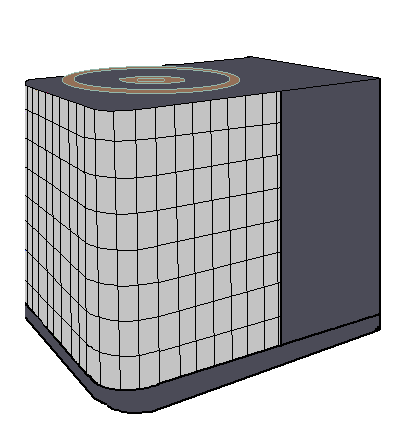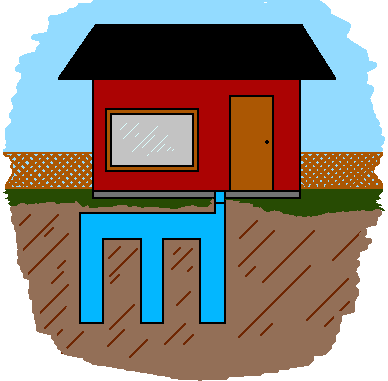SO . . . WHAT IS A HEAT PUMP?
- GOAL:
- The student will understand how a heat pump operates to heat and cool a home.
- OBJECTIVES:
- The student will be able to:
- 1. Describe how a heat pump heats and cools a house.
- 2. Explain the difference between an air-to-air and a water source heat pump system.
- 3. State advantages and disadvantages of using a heat pump.
- LESSON / INFORMATION:
- Answer these questions BEFORE you read this activity packet. AFTER reading, come back and see how much you have learned!
- ACTIVITY 1:
- 1. What is a heat pump?___________________________________
- ___________________________________________________________
- 2. Can a heat pump heat and cool a home?___________
- ___________________________________________________________
- 3. How does a heat pump work?_____________________________
- ___________________________________________________________
- The heat pump is considered the most energy efficient, electrically operated HVAC (heating, ventilation, and air conditioning) system on the market today.
- The heat pump is a year round heating and air conditioning system that uses refrigeration equipment to provide cooling/dehumidification and heating. The freon or SUVA used in the system absorbs and moves heat. In the winter, the freon absorbs heat from the outside and pumps it into the house. In the summer, the heat pump absorbs heat from inside the house and pumps it outside.
- There are basically two types of heat pumps:
- 1. The air-to-air system pulls heat from the outside air and brings it into the house for heating during the winter months. In the summer, it pulls heat from the inside air and releases it outside. Air-to-air units work well in the southern coastal region where winters are relatively mild and the temperature does not remain below freezing very long. (See Figure 1)

- Figure 1
- 2. The water source system uses water as a source of heat exchange. Water is circulated through ground loops in the water source heat pump to help absorb heat from the home in the summer and provide heat to the home in the winter. (See Figure 2)
- The water-source heat pump is considered more efficient as the ground remains at a more stable temperature, around 60°F to 70°F.

- Figure 2
- The air heat pump requires a supplemental heating system for very cold days. Even with this system, however, it is estimated that heat pumps cost 40% to 65% LESS to operate than the more conventional, resistant electric heating and cooling system.

- Figure 3
- When purchasing a heat pump, it is important to know that the energy efficiency of these systems differ. Heat pumps are rated by their S.E.E.R. (seasonal energy efficient ratio) for cooling and their H.S.P.F. (heating seasonal performance factor) or C.O.P. (coefficiency of performance) for heating.
- SEERs range from 8 to 15 and HSPFs or COPs from 5 to 8. In each case, the higher the number, the more energy efficient the system. A SEER of at least 10 and a HSPF/COP of at least 6.0 is recommended. Initial cost of higher efficiency systems may be greater, but energy savings should make up for this investment.
- ADVANTAGES.
- 1. More even temperatures.
- 2. More comfortable humidity level in the winter; not too dry.
- 3. Less noise and odor.
- 4. No pilot light or vent to worry about.
- 5. No seasonable change over.
- 6. Only one fuel bill.
- 7. May supply hot water with excess heat generated during the summer.
- 8. Fewer home fires are caused with heat pumps in comparison to gas heating.
- DISADVANTAGES.
- 1. The major disadvantage of the air-to-air system heat pump is its inability to operate well at very low temperatures and thus requiring a back-up system. In the Gulf Coast region, however, extremely cold temperatures are not often a problem.
- 2. Another disadvantage is that some people find the air provided by the heat pump "cold" in the winter months. While this air is actually as warm as 105°F, the cool feeling can be lessened by directing air registers towards walls instead of directly downward, though this sometimes lowers heating effectiveness.
- 3. Very expensive up front costs for water source heat pumps.
- RESOURCES:
- Baker, Gene and Peavy, Margaret M. Keep Home Heating & Cooling Equipment in Top Shape, Publication 2000(A-4). Cooperative Extension Service, Louisiana State University, Baton Rouge, LA, n.d.
- Building Energy Efficient Homes in Louisiana. Louisiana Department of Natural Resources, Baton Rouge, LA, n.d.
- Design One: Heat Transfer and the Utility Bill. SLEMCO, Lafayette, LA, n.d.
- Slemco Builder's Guide for Energy Efficient Construction. SLEMCO, Lafayette, LA, 1988.
- INFORMATION CHECK
- 1. What does the term HVAC refer to?
- 2. What is the purpose of freon or SUVA in the heat pump? What does it do?
- 3. What is the difference between an air-to-air heat pump and a water source heat pump?
- 4. What is SEER and HSPF / COP? What should we know regarding these terms when purchasing a heat pump?
- 5. List five advantages of a heat pump over the more traditional heating/cooling systems.
- TEACHER'S NOTES
- ACTIVITY 1:
- 1. A heat pump is a new type of electrically operated HVAC. It uses a refrigeration unit and freon, or SUVA, to transfer heat between the house and outdoors.
- 2. Yes. A heat pump can act as an air conditioner in the summer for it absorbs heat from inside the house and moves it outside. In the winter it acts as a heater by absorbing heat from outside and bringing it inside the house.
- 3. The heat pump uses freon, or SUVA, to absorb and move heat. In the winter, the freon absorbs heat from outside air or water and brings it into the house. A supplemental heating system is also used. In the summer, the system absorbs heat from inside the house and deposits it outside, thus cooling the interior.
- DEFINITIONS:
- 1. Freon or SUVA -
- The principal ingredient in a refrigeration system that absorbs heat; a coolant.
- ANSWERS TO INFORMATION CHECK:
- 1. Heating, ventilation, and air conditioning system.
- 2. Freon, or SUVA, absorbs and moves heat. In the winter, freon absorbs heat from outside air or water and brings it into the house. In the summer, the freon absorbs heat from inside the house and pumps it outside.
- 3. An air-to-air heat pump moves heat from outside air to inside air, or vice versa. In the water system, it is water that is used as a source of or a receiver for heat.
- 4. The SEER is the energy efficiency ratio and it tells how well the system cools. The SEER range is from 8 to 15. The HSPF is the coefficient for performance and it tells how well the system heats. The HSPF / COP ranges from 5 to 8. When purchasing a heat pump it is important to know that the higher these numbers, the more efficient the system. Purchase a heat pump with an SEER of at least 10 and a HSPF / COP of at least 6.0.
- 5. Some advantages of the heat pump include:
- - It is considered the most energy efficient electric HVAC system.
- - It can save from 40% to 65% on operating costs over traditional electric heat.
- - It provides a more even temperature.
- - It provides a better humidity level in the winter.
- - It has little noise or odor.
- - There is no pilot light or vent to worry about.
- - No seasonal change over between systems.
- - Only one fuel bill.
- - May heat water during the heating or cooling stage of operation through a heat transfer.
- - Less chance of heating system causing a fire.
Comments or questions to: TechAsmt@LA.GOV
Return to Home Energy Menu





